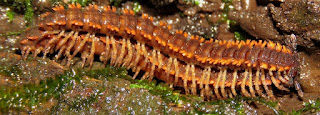January 1 didn’t start at the crack of dawn for anyone at Cristalino Lodge – the night before saw everyone greeting the new year with live music and an amazing feast put on by the staff. Yet I was up to the bird sounds and enjoyed the activity from the floating deck after our leisurely 7:00 a.m. breakfast. In addition to Purple Honeycreeper and Southern Beardless-Tyrannulet, the mob I stirred up included these Blue-gray Tanagers and Red-capped Cardinals.
The trails beckoned, and this morning Susanne and I set out on a short loop past Tower 1 to look for mushrooms. It didn’t take long before she spotted this Ophiocordyceps australis, a rather common entomopathogenic fungus here. All you have to do is spot the tiny, red fruiting body from 1 ½ meters away.
Not far down the trail we thought we had spotted yet another one. But both of us were taken by surprise when it moved, and we had to spend some time watching this creature and look at our macro photos before we could decide what it was. The red dot is in fact a parasitic mite, and the host is a very small assassin bug in the subfamily Emesinae, called thread-legged bugs.
I don’t see many millipedes here in the dry season, but now in the middle of the rainy season, it’s clear that there’s a healthy diversity of species, apparently many scarce. I hadn’t seen this one before, distinctive with the two prongs on the edge of each segment, yet these two certainly seem to have found each other without trouble.
Susanne was here for about a week before I arrived and had been keeping an eye on this giant mushroom, growing significantly every day. It’s been known by at least a couple scientific names, both apparently wrong, and recently has been assigned to the genus Kusaghiporia, formerly known only from Africa.
This same stretch of the trail was beneath a tree dropping its fruits, and the local guides showed us that the white pulp is sweet and quite edible. The tree is Tetragastris altissima, and it’s in the family Burseraceae, same as gumbo-limbo and elephant trees.
By far our best find in the morning was this spider, a giant crab spider (family Sparassidae), possibly in the genus Olios, killed by what looks like Ophiocordyceps engleriana. It’s in amazing condition, as the more common Gibellula fungus that attacks spiders envelops them completely.
We had a slower afternoon on the Tower II trail, but I still found something fascinating. A small dead tree trunk next to the trail was covered in a black sheet fungus, probably in the genus Camillea. But what intrigued me were over a dozen plant bugs (family Miridae) all over it. I assume they were feeding on it, but it’s a hard, crusty fungus that doesn’t seem very edible.
When I looked closer there were two or three ants in the genus Ectatomma that seemed to be patrolling the fungus as well.
I wasn’t sure what the ants were after until I saw one of the plant bugs get too close to one, and in an instant it was in the ant’s jaws.















No comments:
Post a Comment